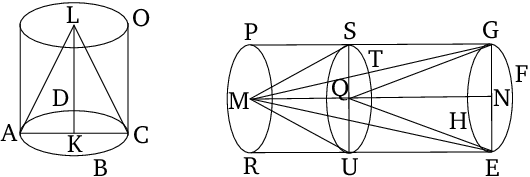Proof: By Euclid
(related to Proposition: Prop. 12.15: Cones or Cylinders are Equal iff Bases are Reciprocally Proportional to Heights)

- For height $LK$ is either equal to height $MN$, or not.
- Let it, first of all, be equal.
- And cylinder $AO$ is also equal to cylinder $EP$.
- And cones and cylinders having the same height are to one another as their bases [Prop. 12.11].
- Thus, base $ABCD$ (is) also equal to base $EFGH$.
- And, hence, reciprocally, as base $ABCD$ (is) to base $EFGH$, so height $MN$ (is) to height $KL$.
- And so, let height $LK$ not be equal to $MN$, but let $MN$ be greater.
- And let $QN$, equal to $KL$, have been cut off from height $MN$.
- And let the cylinder $EP$ have been cut, through point $Q$, by the plane $TUS$ (which is) parallel to the planes of the circles $EFGH$ and $RP$.
- And let cylinder $ES$ have been conceived, with base the circle $EFGH$, and height $NQ$.
- And since cylinder $AO$ is equal to cylinder $EP$, thus, as cylinder $AO$ (is) to cylinder $ES$, so cylinder $EP$ (is) to cylinder $ES$ [Prop. 5.7].
- But, as cylinder $AO$ (is) to cylinder $ES$, so base $ABCD$ (is) to base $EFGH$.
- For cylinders $AO$ and $ES$ (have) the same height [Prop. 12.11].
- And as cylinder $EP$ (is) to (cylinder) $ES$, so height $MN$ (is) to height $QN$.
- For cylinder $EP$ has been cut by a plane which is parallel to its opposite planes [Prop. 12.13].
- And, thus, as base $ABCD$ is to base $EFGH$, so height $MN$ (is) to height $QN$ [Prop. 5.11].
- And height $QN$ (is) equal to height $KL$.
- Thus, as base $ABCD$ is to base $EFGH$, so height $MN$ (is) to height $KL$.
- Thus, the bases of cylinders $AO$ and $EP$ are reciprocally proportional to their heights.
And, so, let the bases of cylinders $AO$ and $EP$ be reciprocally proportional to their heights, and (thus) let base $ABCD$ be to base $EFGH$, as height $MN$ (is) to height $KL$.
- I say that cylinder $AO$ is equal to cylinder $EP$.
- For, with the same construction, since as base $ABCD$ is to base $EFGH$, so height $MN$ (is) to height $KL$, and height $KL$ (is) equal to height $QN$, thus, as base $ABCD$ (is) to base $EFGH$, so height $MN$ will be to height $QN$.
- But, as base $ABCD$ (is) to base $EFGH$, so cylinder $AO$ (is) to cylinder $ES$.
- For they are the same height [Prop. 12.11].
- And as height $MN$ (is) to [height] $QN$, so cylinder $EP$ (is) to cylinder $ES$ [Prop. 12.13].
- Thus, as cylinder $AO$ is to cylinder $ES$, so cylinder $EP$ (is) to (cylinder) $ES$ [Prop. 5.11].
- Thus, cylinder $AO$ (is) equal to cylinder $EP$ [Prop. 5.9].
- In the same manner, (the proposition can) also (be demonstrated) for the cones.
- (Which is) the very thing it was required to show.
∎
Thank you to the contributors under CC BY-SA 4.0! 

- Github:
-

- non-Github:
- @Fitzpatrick
References
Adapted from (subject to copyright, with kind permission)
- Fitzpatrick, Richard: Euclid's "Elements of Geometry"
